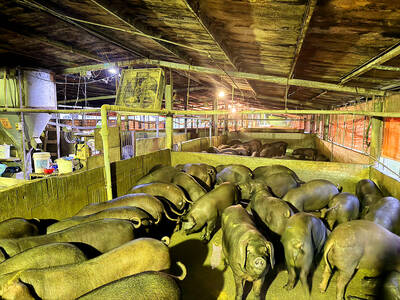It is the most celebrated aircraft on earth. Its mission: to transport and protect the president of the US. She stands as tall as a six-story building and almost as long as a football field. More than a plane, Air Force One is a monument to American know-how and pride. The presidential jet shares the airframe of a 747, but little else. From the wheels up, it has been re-engineered, with flight capabilities and top-secret onboard defenses that surpass any plane in her class. The United States Air Force has done amazing things with this aircraft to make sure the president is very well protected. In a time of crisis, the plane is outfitted to serve the commander-in-chief as an aerial bunker.
這是世上最著名的飛機,其任務是載送和保護美國總統。她有六層樓高,將近一座足球場的長度,「空軍一號」不只是普通飛機,還集結了美國專業技術與驕傲之大成。這架總統專用噴射機援用747機身結構,但其他部分則大不相同,從機輪起全是重新打造,不只有飛行能力,還有超越所有同級飛機的高機密機上防禦系統。美國空軍徹底改造這架飛機,以確保總統受到全面保護。遇到危機時刻,機上也有完善設備能作為最高統帥的空中碉堡。
Sept. 11 was over. But for the men and women of the Presidential Airlift Group, there was work to do. Air Force One was about to face action in a dangerous new world. Report any suspicious activity, do not engage unless your life is threatened. Their next mission will test security to the max. Air Force One is headed for the most troubled region on Earth — the Middle East. From Israel to Saudi Arabia to Egypt, the president’s plane must be ready for anything. More than the shifting sands of a troubled region, the Middle East also harbors manmade threats. Air Force One is ready to defend against attack. Technicians climb overhead to check out one of the plane’s strictly off-limits areas. It’s the section of the airplane that is referred to as the attic — it runs almost the entire length of the airplane, and it runs over the top of all the passenger compartments. It’s pretty much the heart, the inner workings of the airplane. Beneath the skin and hidden from view, the plane carries an array of sensitive and secret features: radio and radar jamming, broad frequency antennas and sensors to track attacks from cyberspace or heat-seeking missiles.
九一一事件落幕,但總統專機小組的工作尚未結束,空軍一號將面臨危險新世界的活動。回報任何可疑活動,除非生命受威脅,否則不要交戰。下一個任務是安全人員的終極挑戰,空軍一號要前往全球頭號戰亂地區──中東,從以色列到沙烏地阿拉伯和埃及,總統專機必須做好萬全防範。除了戰亂地區的不穩定情勢,中東還可能出現人為威脅,空軍一號要做好防禦攻擊的準備。技師爬上飛機頂檢查機上限制嚴密的區域之一,這個部位我們稱為閣樓,裡面幾乎跟整個機身等長,位於所有客艙上方,這是飛機內部運作的核心。隱藏在機身蒙皮下方有一系列敏感機密設備,無線電和雷達干擾器、寬頻天線,還有追蹤網際空間或熱導飛彈攻擊的感應器。
If the president goes somewhere, he’s going on Air Force One. To guarantee that the president always has a plane ready to fly, the airlift group operates not one but two jumbo jets, identical in every detail — the primary and the backup. Wherever Air Force One flies, its twin is always on hand — and ready to take over. Failsafe operations start with engineering. The plane’s jet engines are unlike any others — not because of special technology, but thanks to meticulous care. For security, Marine One always flies with identical helicopters. Officially, Air Force One is not a plane but an air traffic call sign. Only after the president steps on board can this military jet assume the name “Air Force One.”
總統去任何地方,都是搭空軍一號,為了確保總統永遠能隨時搭上飛機出發,總統專機小組準備了兩架完全相同的巨無霸噴射機,一架是主要飛機,另一架備用,不論空軍一號飛往何處,備用飛機都在附近準備接手。萬無疏失的行動起於工程,空軍一號配有獨一無二的噴射引擎,這不是特殊科技的產物,而是因為細心保養。為了安全起見,「陸戰隊一號」向來與同型直升機隨行。正式來說,空軍一號不是特定飛機,而是航管呼叫代號,只有在總統登機之後,這架軍方噴射機才會被稱為「空軍一號」。
Fifty-two crewmembers will make the trip, twenty-six aboard each plane. There are flight crew, communications, engineering, cabin crew and, of course, security. Air Force One flies with four crewmen: pilot, co-pilot, engineer and navigator. Air Force One transports more than just the president. It carries a full White House team: political and diplomatic aides, military attaches and the press.
這趟行程將動用五十二名機組員,每架飛機各二十六人,包括飛航、通訊、工程和客艙人員,當然還有安全人員。空軍一號配有四名飛航人員:機長、副機長、飛航工程師和領航員。它不只載送美國總統,還包括整組白宮人員:政治與外交幕僚、武官,當然還有媒體。

For many people in Taiwan, childhood memories of rural life include pig pens standing beside family homes. Leftover rice, vegetable scraps and soup from daily meals were poured into buckets and fed to pigs. This practice of feeding pigs with household food waste was once a common way of life, both an economic choice and an expression of agricultural society’s deep respect for conserving resources. From a practical standpoint, pigs are omnivorous animals capable of efficiently digesting food scraps that humans can no longer eat. For rural households, food waste cost almost nothing, yet it could be converted into pork, a

A: Apart from the Taipei Music Center’s exhibit and concert, US pop rock band OneRepublic and rapper Doja Cat are touring Kaohsiung this weekend. B: OneRepublic is so popular that after tonight’s show at the K-Arena, they are set to return to Taiwan again in March next year. A: And Doja will also perform at the same venue on Sunday, right? B: Yup. Her collab with Blackpink’s Lisa and singer Raye for the song “Born Again” has been a huge worldwide success. A: Doja even made it on Time magazine’s “100 Most Influential People” list in 2023. She’s so cool. A: 本週末除了北流的特展和演唱會外,美國男團共和世代和饒舌歌手蜜桃貓朵佳也將來台開唱。 B: 共和世代因太受歡迎,繼今晚高雄巨蛋的演唱會後,預計明年3月即將再度來台巡演唷。 A: 朵佳本週日將在同場地開唱,對不對?

Tango unfolds in a dimly lit room, where a haunting melody ushers two dancers into a close embrace. Here, music and movement merge into a silent yet passionate conversation, expressing longing, memory and shared purpose. What makes tango truly magical is the deep interaction and spontaneous improvisation between partners. Tango began in the late 19th century in Buenos Aires, Argentina’s bustling capital. Born in the poor working-class neighborhoods and busy port areas, this dance emerged from a melting pot of cultures. European immigrants, African slaves and local residents all contributed to its unique character. From these rich influences, tango

A: What show are you watching online? B: I’m watching “Fly Me to the Moon & Back” – an exhibition launched by the Taipei Music Center (TMC) to commemorate the late singer Tom Chang. A: Known for his sky-high notes, Chang is praised as one of the best singers in the 1990s. His death at the age of 31 was a major loss indeed. B: And I’m so glad that we went to the TMC’s 90s-themed concert last Friday. I finally saw the iconic “Godmother of Rock” WaWa perform live. A: This year-end show also featured singers Princess Ai, Bii, Wayne Huang, PoLin and